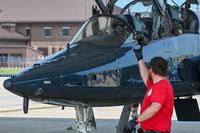The U.S. Air Force has implemented recommendations from an Intelligence, Surveillance and Reconnaissance (ISR) review in the past year, building upon findings from a 2011 assessment of platforms, sensors and data collection requested by Air Force Secretary Michael Donley, senior service officials explained.
In particular, recommendations from the comprehensive review, which was completed in the Fall of 2011, looked at network architecture for ISR, targeting capabilities and data analysis, said Lt. Gen Larry James, Deputy Chief of Staff, Intelligence, Surveillance and Reconnaissance (ISR).
The review was conducted with a mind to ISR missions and accomplishments in recent years supporting combat sorties in Iraq, Afghanistan and Libya, among others -- and also geared toward streamlining and synchronizing capabilities such that the Air Force can successfully operate in “more-contested” future environment, James explained at a breakfast in Washington D.C.
“We’re talking about full-spectrum awareness – to take information and data from any source and create knowledge of it, process data and airborne sensors. If you look to the future and a contested environment – anti-access/area denial -- you have to be able to take any source of data and help create that knowledge whether it’s a satellite system, an F-22, F-35, cyber system or open source information,” James said.
With these themes in mind, James articulated the service’s progress in 2012 implementing key findings from the review, recommendations which paid mind to the Pacific pivot and its broader implications regarding the need for ISR capability to operate effectively in a more technologically challenging environment.
One key was consolidating the network architecture for ISR, so as to ensure that data can easily be exchanged between platforms including sensors and command and control nodes, James said.
“We want to make sure we can move all this data around,” James added.
Part of the review’s recommendations includes recognizing the fiscal constraints of the current budget environment and looking at what the Air Force would do if more money were available.
Adding pertinent information to a large “targeting” information data base is also a huge part of the ongoing ISR review, James said. In fact, 88 new billets were added to the Air Force targeting center -- an effort which helps fighter pilots and air crews develop targeting information and a better awareness of their battle space.
“During Libya the Air Force targeting center played a really important role in terms of our ability to create a combat operating picture and do the collateral damage estimates," James explained.
The Air Force Targeting Center is located at Langley Air Force Base, Va., service officials explained.
Another key part of progress with the review hinges upon use of what’s called the Distributed Common Ground System (DCGS), an integrated database able to compile, organize and communicate huge amounts of otherwise disparately collected intelligence. It collects from Geospatial intelligence, GPS, human intelligence [HUMINT], signals intelligence [SIGINT] and input from a wide range of airborne and ground sensors, among many others.
“As we look at the future and the handling of data, one of the things the [Donley] directed was within the DCGS line. We’re building a roadmap for DCGS. We’re moving to a service-oriented architecture and moving to non-proprietary software,” James explained.
Using non-proprietary software will enable an integrated computer data base such as DCGS to more readily accommodate new applications and technological advances as they occur, James added.
“The other roadmap we’re building is an analytic road map to fuse data together and create a product that the analyst can use more efficiently and effectively to create knowledge for the commander,” he said.
There is much data, video and intelligence information to compile, James explained. For instance, there are 35,000 airmen doing analysis around the globe – producing 3,000 SIGINT reports in one day and processing about 1,900 still images and generating over 200 weapons reports, James explained.








